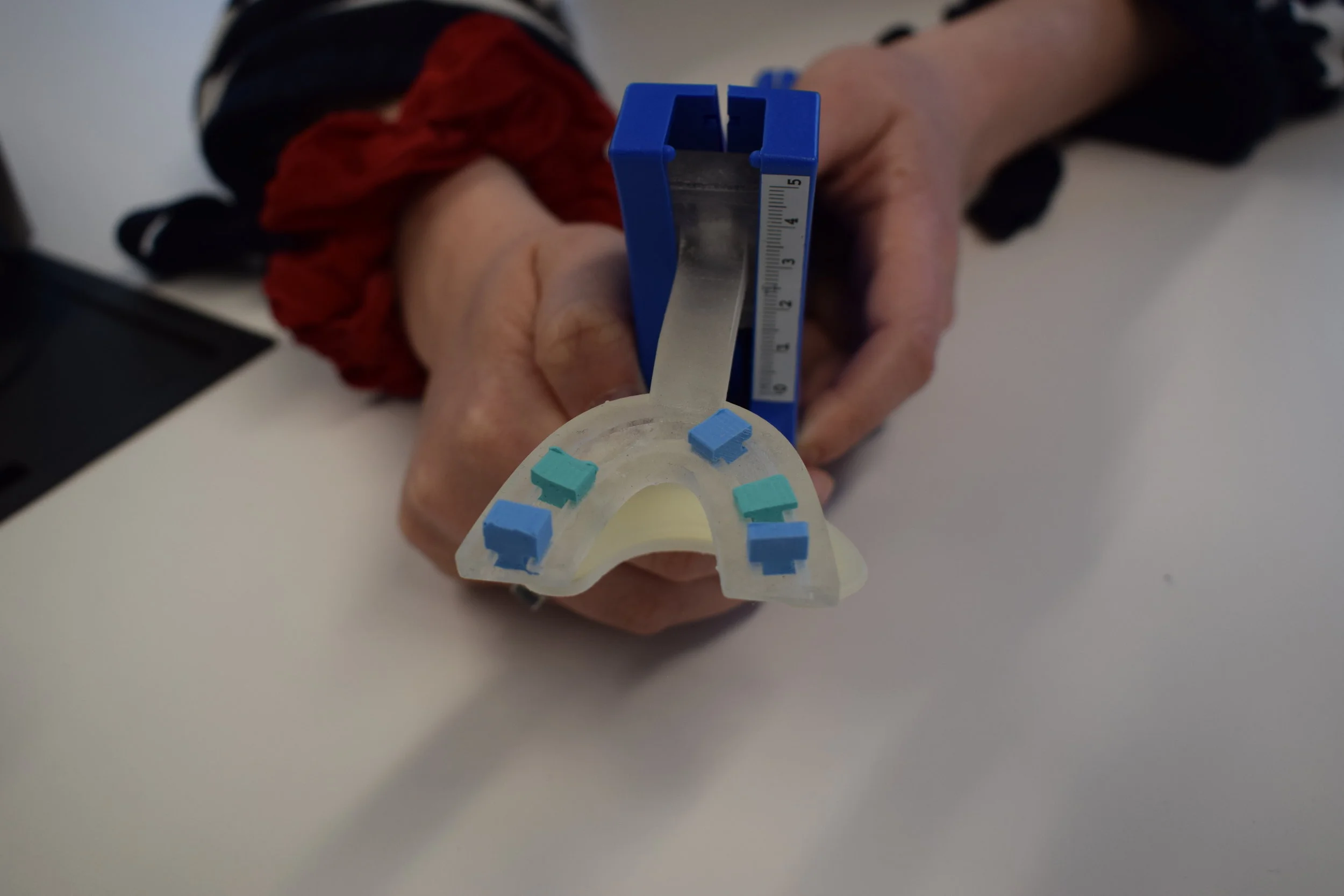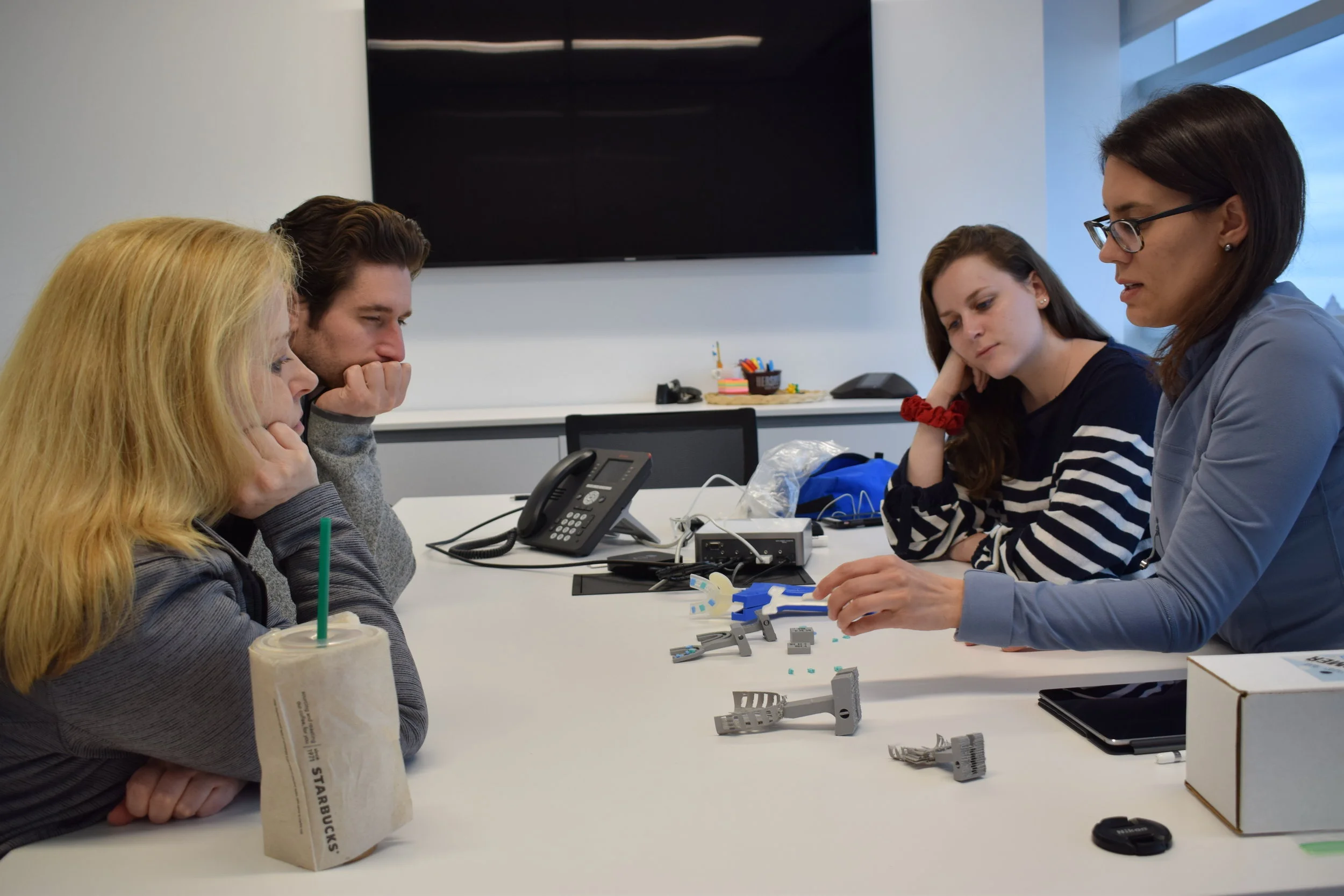Therabite Redesign Full Case Study
3D Modelling
🛠: User Research, Rhino
💁♂️: Laura Ceccaci, Anna Dailey
⌛: 8 weeks
Through a graduate design class, we (Anna, Saif and Laura) have been working with Dr. Mike Tecce, a Penn Medicine Plastic Surgery resident and the Children’s Hospital of Philadelphia on ways to improve care for pediatric patients with trismus.
MEET SARAH
This is Sarah. She’s an 8-year-old patient and was born with trismus. This means she has difficulty extending her jaw for full range of motion, and so she sees an occupational therapist for treatment. Like many eight year olds, some teeth in her mouth are missing or haven’t erupted yet. However, she is unique because she has a severe overbite, which affects her biting and chewing.
How would they treat this? Sarah’s doctor and occupational therapist would help her stretch the muscles in her jaw using a device called Therabite. However there are some significant limitations with this device.
Too standardized for patients with irregular dentition: it doesn’t account for a narrow range of motion.
Doesn’t account for small range of motion: too much pressure on the anterior teeth could lead to looseness and wear away gums.
Jaw extension but not rotation: different strokes for different folks.
We asked ourselves: how might we create a solution for treating trismus, that is scalable and user friendly, but also customizable for a wide variety of pediatric patients?
USER INTERVIEWS
In order to better understand the landscape, we wanted to interview every type of stakeholder that had is involved or affected by this problem. We spoke with members of the clinical care team who work closely with patients, like occupational therapists and Dr. Tecce, the plastic surgery resident. Dr. Tecce conducts surgeries on pediatric patients that will be prescribed the Therabite to regain mobility post-surgery, and the occupational therapists work most directly with the patients as they move through their treatments.
We also spoke with family members and care givers, as oftentimes the parents conduct the stretching at home. In addition, we spoke to medical device experts about the design of the Therabite device and our own design ideas, the Therabite manufacturer/distributor, and of course, the patient, who is the center of our focus.
With our user research, we identified 3 main pain points patients had:
Some patients had damaged angles of dentition through trauma and the bite plate wouldn’t evenly spread pressure, so our solution needed to be customizable
Other patients did not want to use the Therabite as it was intimidating and the roughness was unpleasant, so we kept in mind optimizing the experience for use
The tough material deteriorated gum thickness, so our material needed to be softer and better for dental use but still durable
APPROACHING DESIGN
We focused in on the bite plate as a priority as this was the most unpleasant part of the experience and, when made customizable, it would have the most direct impact in the shortest time frame.
We split up the complete redesign of the Therabite into the bite plate, the handle and the extensor (which needed to allow for rotating components for irregular jaw angles). Our decision to focus on the bite plate rather than do a mediocre job at all three meant handing off the project would be easier and we would get better results.
In our initial prototyping phase, we first came up with the customizable and modular kit, which incorporated a large degree of freedom in displacement, angle and dentition. We had initially planned to use a thick wire material or rod for this one as it would be regularly available and hence unnecessary to print on demand.
Our second prototype was the T-shape bite plate made from foam core, which was very soft and put pressure on the molars rather than the front teeth. This would reduce pain and spread the pressure over teeth with greater surface area.
Prototypes
Rhino Design
RAPID PROTOTYPING
We then transitioned into a prototyping phase where we moved forward with all the ideas and added in one Dr. Mike suggested looking into combining an impression tray like the DinoSplint kit.
The modular sliding track was a combination of both the modular wire bite plate kit and the initial Therabite’s bite plate - we received feedback from Dr. Richard Lin that incorporating a track would allow a greater degree of freedom with gummies but still keep the gummies in plate (the gummies may rotate on a wire or rod).
The second design was a further implementation of the T shape using dental resin combined with the handle. This is an alternative to the track that would be used mostly in cases with front teeth damage.
We also created an impression tray device for patients who could open their mouth wide but had significant dentition damage and so need an accurate plate to push down. This would be combined with the same silicone using in the DinoSplint to make a quick impression that dries and then fits into the mouth seamlessly.
TESTING & CONVERGENCE
After we developed our three independent prototypes, we tested these three concepts with our key users: Dr Tecce, a plastic surgery resident, and two occupational therapists that treat trismus patients daily, Anne-Ashley and Tammi. We also got mechanics advice from device expert Dr. Richard Lin.
These testing sessions illuminated some amazing insights.
Overwhelmingly positive feedback about the modularity component of prototype #1. The doctor’s loved the idea of being able to take a glance into the mouth and assemble a perfect solution for the patient, without any scans or molds.
The impression molding was the best for customization, but doctors worried about adding in another, not very user-friendly, step to the process.
Positive feedback about our T-shape design, as it reaches the back molars for better leverage.
“This is phenomenal - it’s more than anyone else in the country has done to solve this problem.”
WORKFLOW
Irregular Jaw Positioning: Different length arms of bottom plate
Unique Bite & Arc Size: Size & shape options for plates
Irregular Dentition: Range of gummy heights and positions based on dentition








